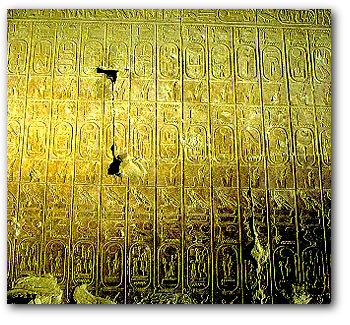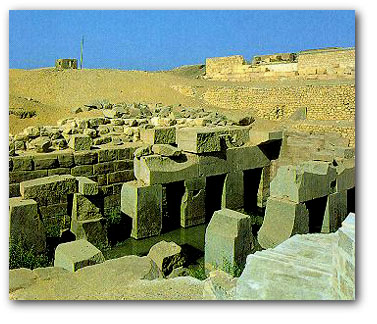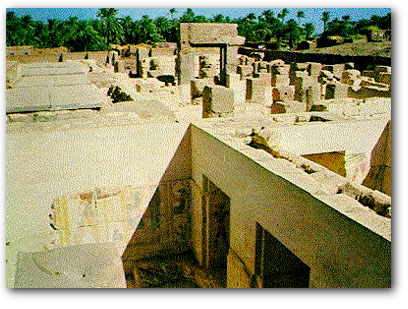Abydos (Abtu)

Location:
Suhag, Egypt
Situated on the West Bank of the Nile, 12 km south-east of Al-Ballyana, it was the chief center for worshipping the god
Osiris.
How to get there:
By daily air conditioned trains, scheduled at regular hours.
By private vehicles, taxis and tourist buses.
For information and reservation contact the Upper Egypt Bus Company which organizes excursions to
Al-Minya. Tel: +20-2-2609304/9297/8.
Description
On the west bank of the Nile, 90 miles (145 km) north
of Luxor, lies the Temple of Abydos. Abydos is linked to
the earliest dynasties recorded, and in 1993, the
earliest known tomb was found here, along with some of
the oldest hieroglyphics ever discovered. The Temple
dates to around 3150 BC, and the records have provided
scholars with much of what is known about the earliest
periods of recorded history. This area, sacred to Osiris, was a very powerful
location to those who believed in the next world. The
ancient Egyptians said that at sunset, the area looked
like a golden staircase leading to the afterlife, and
thus many people wished to be buried here. It was here,
too, that Osiris, after being killed by his brother Seth, returned to power. Seth had
killed Osiris and scattered the pieces of his body all
over Egypt. Osiris' wife and sister, Isis,
gathered the pieces one by one, put them back together,
and restored life to her husband. It was said that Abydos
was where the final piece, his head, was buried, and so
it was here that Osiris was brought back to life to
become the judge of the dead and lord of the netherworld.
The Temple of Osiris
The original Temple of Osiris was built by Seti I, who came to power 29 years
after the collapse of the regime of Akhenaten.
Seti wished to restore the beliefs in the traditional
gods and so built this temple to show his devotion. The
way leading into the temple had two courts and a pylon,
which were built by Ramesses II.
The way these courts and pylon were positioned gave the
entrance the illusion of sloping upwards. Sadly, this
entrance has been mostly destroyed. The front of the
temple is now 12 rectangular pillars, covered with sacred
images welcoming Osiris, Isis, and Horus.
The first (outer) hypostyle hall was built by Ramesses,
but the quality of the decorations on the columns are not
as impressive as those found in the second (inner) hall,
which Seti built. It is widely thought that Ramesses used
the best craftsmen in building his own temple, but used
lower quality workers on this temple after the death of
Seti. Just beyond the second hall are the seven separate
sanctuaries dedicated to Seti I, Osiris, Isis, Horus, Amen, Mut, and Khensu. Originally, seven doors led
to the sanctuaries, but Ramesses, for reasons still
unknown, had all but one covered over. When the temple
was in use, each of the sanctuaries would have contained
the god's barque (sacred boat), and would have had a
stele placed in front of a false door. The sanctuaries
were locked and only the high priests of each god could
enter, as the Egyptians believed that the gods actually
lived inside their sanctuaries. The sanctuaries are
highly decorated with bas-relief paintings dedicated to
the several gods of the temple. Many of the bas-reliefs
in the sanctuaries still have their coloring, but the
best decorations are the masterful unpainted moldings.
One scene in Seti's sanctuary shows him being crowned by
the goddess of Upper and Lower Egypt, but by far the most
incredible paintings are the ones found in Osiris'
sanctuary. The temple also possesses a King's Gallery, a
room that lists all over its walls the names of the gods
along with over 70 of Seti's predecessors (minus some
omitted for political reasons such as Akhenaten and Hatshepsut), making it an
invaluable resource for historians.

The Osirieon
Through the rear door of the temple is the Osirieon,
the only visible tomb at this site, which was built
before the main temple. Much of the damage to the
Osirieon has been from flooding, as it was built at water
level, yet it is not much diminished. Red Aswan granite
pillars, each weighing about a hundred tons apiece,
support equally massive archways. This temple was built
as a symbol of Seti's closeness to Osiris and contains a
sarcophagus, though Seti was not buried here. Seti's
actual tomb is in the Valley of
the Kings in Luxor. This was a fairly common practice
among many of the pharaohs, having "public"
tombs in one location, but actually being buried in
another. The Osirieon is currently inaccessible because
of the rising sand and the flooding that has occurred.
Excavation has been done on the south side passage, which
revealed texts from The Book of the Gates and The Book of
What is in the Duat. This section was begun by Seti and
finished by his grandson, Merneptah.
It is a complete tomb structure, all ready to receive the
mummy of a king, yet it does not appear ever to have been
used so.
Abydos does have a reputation for these "false
tombs" or cenotaphs. Some theorists state
that Abydos does not even have a single actual tomb in
it, but that all the dead who have tombs at Abydos are
actually buried elsewhere. The cemeteries of northern
Saqqara certainly have a great number of royal mastabas,
of which many have been linked to the Archaic rulers. It
is very possible that actual burials of kings and
high-ranking officials were carried out at Saqqara, which
is near Memphis, the new court city. Thus the monuments
at Abydos are precisely that: monuments. It is fairly
simple to see why this might be so. The rulers would no
doubt have a desire to be buried near the place they
ruled, but Abydos was also a powerful site because of its
religious ties, as well as being deep in the ancient
homelands. Thus, the rulers arranged to have themselves
"buried" in both places. The body at Saqqara or
another site, and a cenotaph built at Abydos. Of course,
the reverse could be true, with Abydos as the true burial
site and all the tombs at Saqqara are cenotaphs. Or
perhaps the explanation involves a little bit of both,
with some rulers desiring to be buried near Memphis, and
others at Abydos, but each ruler building two tombs, one
in each location.
It would be rather unusual for the rulers to remain as
visible as possible in their new capital during life, and
then at death, simply passing from view. Thus much of the
current consensus is that Saqqara is the actual burial
site and that Abydos is the site of the royal monuments.
The tombs at Saqqara as a whole are larger and more
luxurious than those at Abydos (with the exception of the
valley "temples" of Abydos which are immense
and have no known Saqqaran counterparts), suggesting that
Saqqara is the true burial site. Yet there are a large
number of subsidiary tombs at Abydos, such as those used
by officials of state, but very few at Saqqara. And
Saqqara is the home of the most famous of the false
tombs, the Third Dynasty step
pyramid of Sekhemkhet,
which remained sealed even to 1955, when the seals were
pierced and it was discovered to have always been empty.
It is a question that may not be easily resolved.

The Temple of Ramesses II
The temple of Ramesses II is a small temple that is
northwest of the Temple of Osiris about 300m. The temple
was built in 1298 BC for Ramesses' spirit to give him a
close association with Osiris. It was originally built
very well and contains work that is better than most of
Ramesses' other monuments. The craftsmen were probably
trained during his father's, Seti I, era. The temple is
mostly in ruin except for the limestone walls which still
contain brightly colored works. Napoleon's archaeologists
reported that the temple was almost intact when they
first saw it.

|





